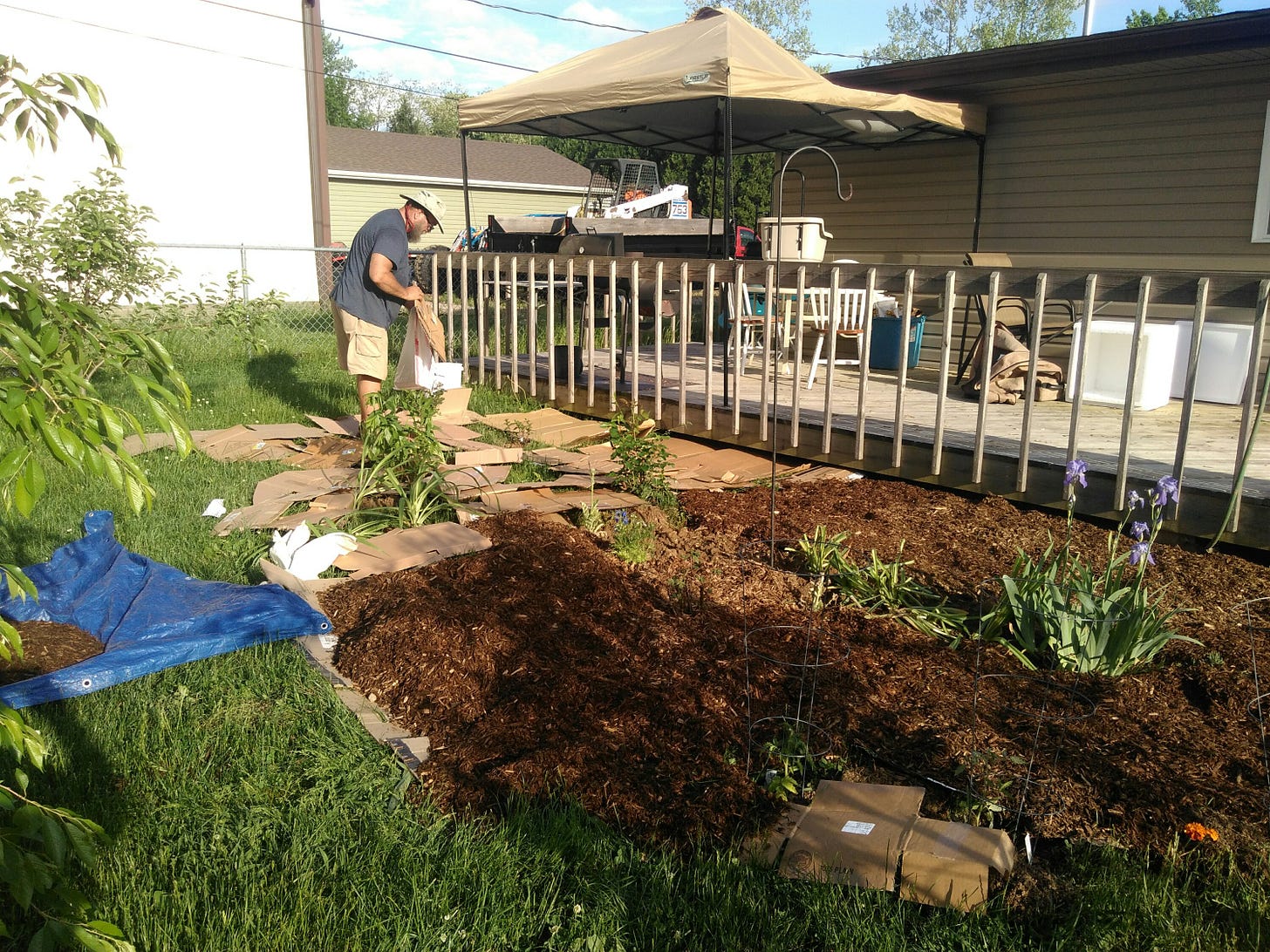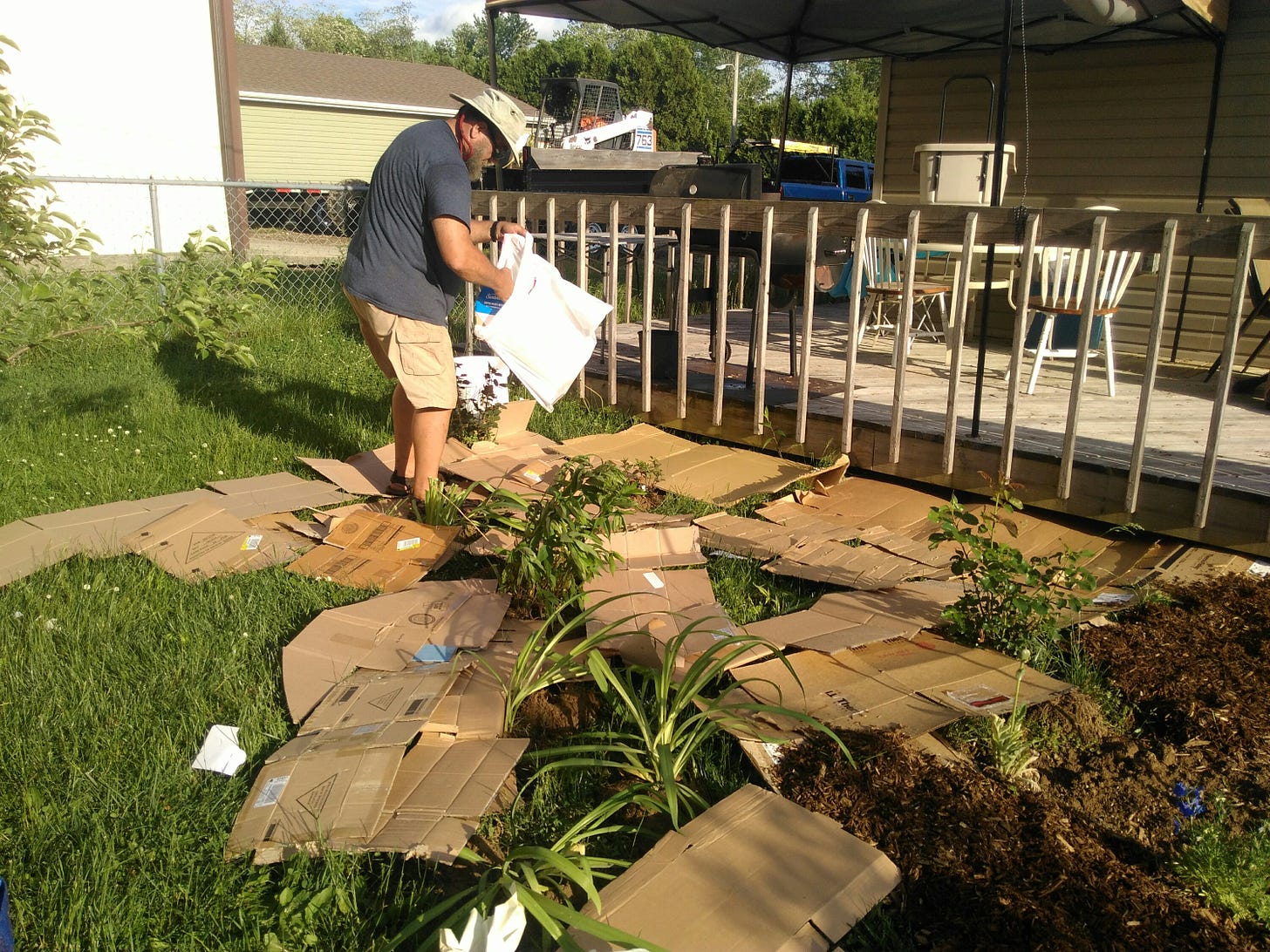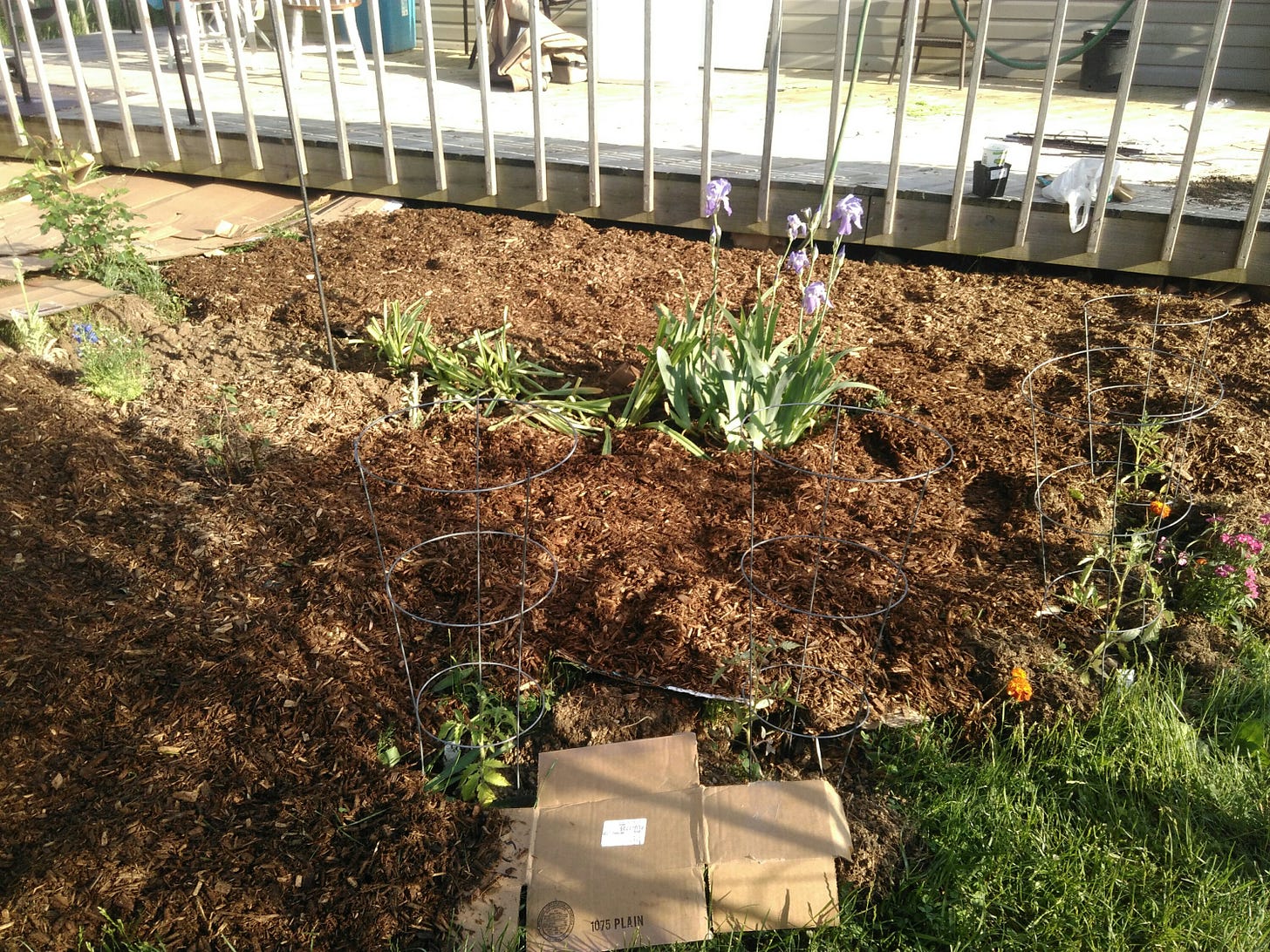Lasagna Gardening
As we've been slowly moving into the new house, I've been slowly establishing the new garden. My plan is to grow herbs, berries, fruit, and possibly some vegetables (more on that priority later) as well as flowers and beautiful plants. We have just over a half-acre of mostly level ground, partially fenced, mostly lawn. I'll be changing that. Slowly. I simply don't have the time and energy for creating the garden I'd like quickly (or, for that matter, the budget). So I'm using a variation on a technique called lasagna gardening.
Also, much of what I'm working on now, is actually for this fall and next year. It takes time to properly establish a garden, especially when you have soil that needs to be amended for best growth. My soil is very close to clay - when you squeeze a handful while it's moist, it stays put and doesn't crumble even a little. I haven't yet sent any in for testing, but I'm sure I'll find that it's on the alkaline side, and traps moisture... which isn't always a bad thing. However, it will need plenty of organic material added to make it better, along with sand, and possibly other nutrients (I have a baby fruit tree with worryingly chlorotic leaves).
When you start out with sod, it's hard to get the land back to garden. Grass is annoyingly persistent. Unless, of course, that you're trying to have a nice lawn, but that's another topic I'm not suited to address: I'm not a fan of the American obsession with grass monoculture. You can, of course, till the ground. Which I attempted to do, and that didn't work out well (did I write that up for the blog, or just facebook?). Also, it just mixes up the ground, it doesn't actually kill the plants so much as bury some and bring weed seeds up to the surface where they will sprout. Ideally, you want the grass to die (die! Die! with screeching violins) so you can access the soil and put in young plants that won't get choked out by the grass, and weeds. There are several ways to accomplish that, but I'm taking the quick and cheap one. I'm even recycling to do it.

With Dad's help, we're breaking down the moving boxes, flattening them out, tucking them around the existing plants, and then we're holding them down with mulch. I bought a couple of yards of what Dad called 'pretty' mulch, which I'll use in the flower gardens. I've got boxes pinned down with landscaper's staples (they are about 5 inches long, and meant to hold down weedcloth) around the berries and trees, they will get a topcoat of mulch when I get some of the 'ugly' raw mulch in. The guy I bought the nice mulch from took my information to give to the guy that does tree trimming, and I'll get raw chips from him, for free. Price is right. And for those, I don't need beautiful. Actually, they'll be an improvement on the boxes!
What this gives me, in addition to killing off the grass and weeds, is keeping moisture in the ground for the plants. While I do have clay, and this is the Ohio River Valley region, with all the moisture that entails, come July I don't want to have to pay (we're on town water) to keep the berries plump and juicy. Mulch is a fantastic way to cut the watering down, which not only saves me money, but time and effort. I'm a lazy gardener. So lazy. Mulching this heavily is a fair amount of work every spring, but then I can lounge on the deck and enjoy the fruits of my labors. Well, ok, maybe it's not that easy. But close.
I'm covering and mulching a larger area than I'm using this spring. What this means is that I can pull back a small section of the mulch - the cardboard will go all mushy and easy to tear through in short order - to plant through it. For Fall, this means putting in bulbs and perennials and the rest of the fruit trees I want. For Spring, I'll be prepping a vegetable garden area this year, in October more than likely. That I plan to mulch after tilling, because I'll acquire some composted horse manure to till in and supplement the soil. I have a couple of horse farms nearby - but you'll note I say composted. Don't just get a load of manure from the farm and tip it onto the garden. Horses don't fully digest many weed seeds, and you'll have an interesting garden for sure! Planning ahead, I can manage a garden without spending hours on it in any given week. A little at a time, after work, is all I can manage, and that's all this will need from me. Well, after the initial burst of prepping.

Dad helping set boxes around my plants. This is zone 1, in permaculture terms, the bed closest to the house. It's got both edibles and flowering plants in it, and it'll be the core of my Artist's Garden when it is fully established.
I'll note that you probably want to avoid 'slick' boxes, with pretty product pictures on the outside. They don't break down well and could add unwanted stuff to your soil. I try to avoid boxes with metal staples in them, but plastic tape I don't care about - contrary to popular myth, plastic breaks down fairly quickly especially when exposed to sunlight. If you find some while cultivating for new plants, you can just yank it out and trash it. Like I said, I'm lazy. A pocket knife for cutting tape, a stack of boxes or cardboard - you can usually get broken-down boxes from a local shop, since if you aren't moving you don't care about using the box to contain and carry. The same results can be had with plastic, but boxes break down and add to the soil over the years, plastic sheeting just gets ugly and you have to trash it. I've used it, but not for flowerbeds. Weedcloth also works fairly well, but again, it doesn't break down quickly (which can be a plus) and I've found it's not great for killing grass or large weeds. It's more something I'd use under mulch on top of already prepared soil to keep down the new weed growth. it definitely needs mulch or something, because it will blow around, even if you think you have it weighted down. It's like a horizontal sail.
As I alluded to earlier, you'll need to spend a little time (and money) each spring refreshing your mulch. You won't need to renew the boxes, more than likely, unless you are expanding a bed or establishing a new garden patch. They break down, but the mulch keeps the weeds at bay just fine after the initial kill. I don't recommend trying to do this with just mulch, the grass will find the thin spots, and enough mulch to settle all the grass and weeds down is also enough to lock up nitrogen until it starts to decay, leaving you with undernourished plants in the mean time. Hugelkultur is a whole' nother topic...
Which means I've probably written enough about this topic for today. No point in boring on and on about my garden, since I know from experience most people's eyes start to glaze over when I get overly enthusiastic about plants. Speaking of which! Does anyone know how to transplant sassafrass?

tomato plants! I'll almost be able to pick while standing on the deck.




